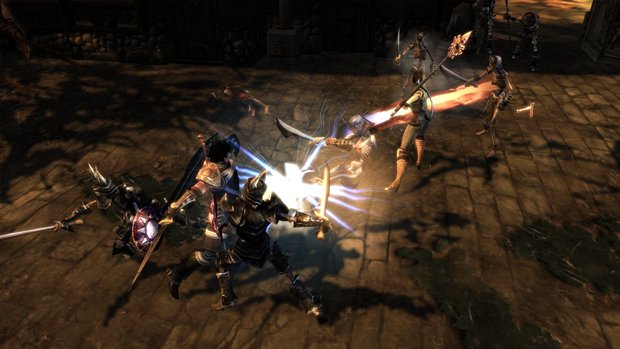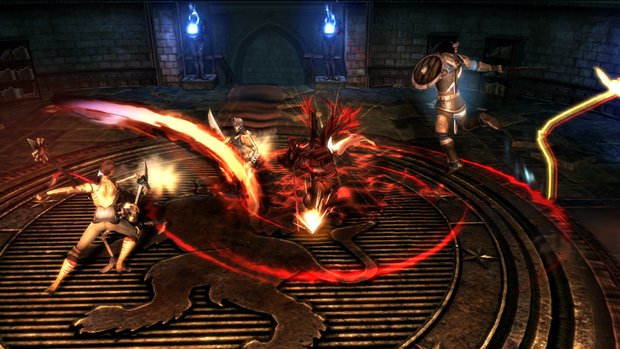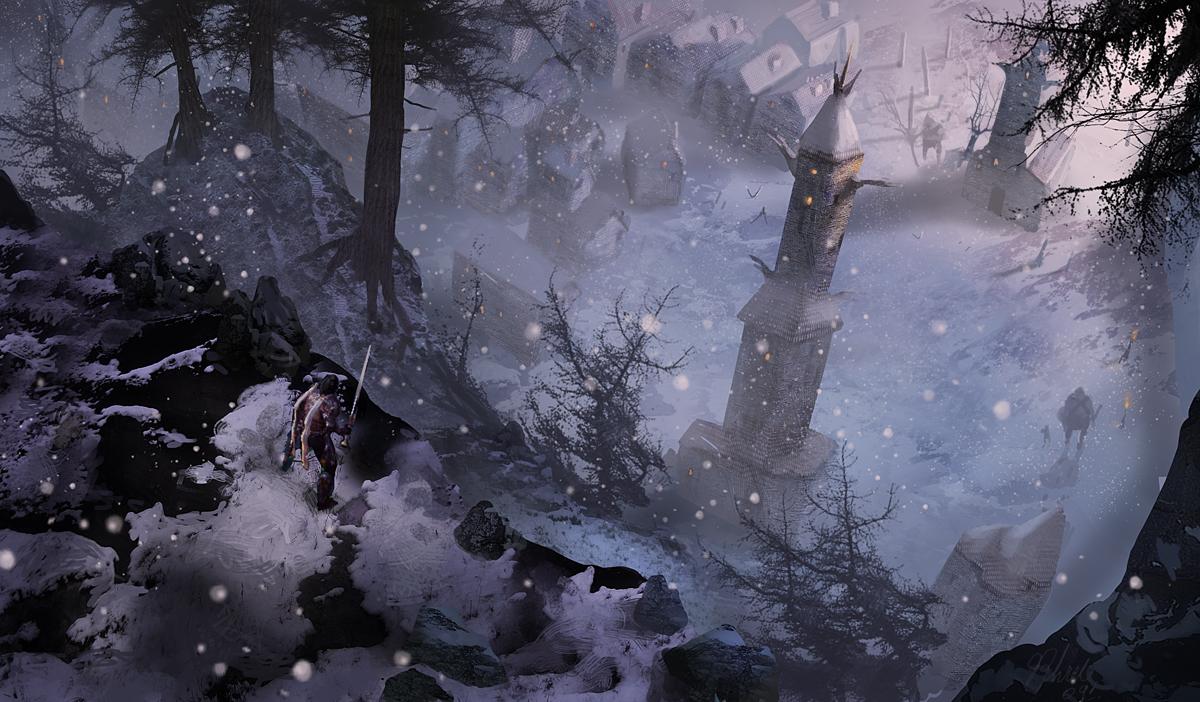Why you can trust GamesRadar+
The towns and other instances of running into NPCs can also slow the pace to a crawl. NPCs begin dialogue similar to Dragon Age and Mass Effect: after an explanation of what’s what, options are presented for more exposition which can increase influence over your AI companion as well as make minor decisions about the overall world, like allying with a particular faction. In the beginning this is fun. By the end, though, you’ll probably skip quickly through dialogue as the decisions you’ve made don’t greatly affect the world. Influence gained over your sidekicks and its use is never fully explained and decisions made over the course of the plot only slightly change the “this is what happened here, and this is what happened here” ending of the game.
The co-op mode is a similar mishmash of undercooked plans. Up to four players (two local and up to four online) can enter a person’s campaign and lend a hand with the thug clubbing. Four people onscreen can really wreak havoc. When everyone’s on the same page, it can make the game quite easy. Most often, though, the more players the more hectic it is. The camera follows the host player. The others have to struggle to adjust to it as they aren’t allowed to leave the host’s radius. In local multi this makes sense since two players are using one screen. Online, though, it’s baffling why everyone can’t follow their own screen. Instead, when the action gets busy, everyone is fighting to go to their specific corner, thus confusing the camera and pissing everyone else off, even though the four of them can logically pound any given target. More baffling is that each player cannot bring their own character build into a multiplayer game, relying on the decisions that the host has made in how they’ve built the allies they aren’t controlling during the main campaign.

Party politics also play a factor. Everyone shares the host player’s bank of money, but they can all go shopping for themselves. When we tested it, each individual player can go to the shop screen and buy their own gear, meaning that if everyone isn’t communicating, player 1 can end up broke before they know it. Dialogue trees with NPCs are also completely at the mercy of the host player, who makes all the decisions. In what feels like a tacked on piece, the other players can cast their vote as to where the conversation can go, but that’s about it.
The plus side is that it’s easy to host and find games. You can set your campaign to let other players drop in and out, and jumping in on a game from the title screen menu is as easy as choosing from the lists available. The one very cool piece of multiplayer is the “take a break” option from the main menu. Since the team cannot move on without everyone following along, you can choose to “take a break” and have AI take over if you need to hit the potty or grab a drink. Of course, trusting a boss fight to it may be less than safe, but it’s a welcome addition to online games.
As a developer, Obsidian has been pretty spotty with how their games perform on a technical level. While this holds true with the console versions of DS3, which are seriously lacking in graphical detail andoften looking like last-gen games, the PC version is quite beautiful, assuming you have the rig to handle it. So there is one way the PC version is superior to the consoles, and it's not minor - the graphics are far, far better on PC with much crisper textures, nuanced spell effects, and great-looking character models in comparison to the horribly smeared console characters.

Alas, here is where we get to the real problem with the PC version: the controls. Wow, are they terrible. If you never pick up a controller to play DS3 you might not realize just how bad the PC controls are (but you'll still realize they're very bad). No concessions have been made for PC gamers - the keymappings are downright awful and you CAN'T CHANGE THEM. First of all, there's no old-school point-and-click option where you can right click on a spot and your character moves to it. Instead, you hold down the right mouse button and your character follows the cursor. That's not so bad, and other PC games have used this approach. It becomes a problem, though, when you need to dodge - and this game requires oodles and oodles of dodging if you want to survive. On console versions you simply point your left stick in a direction and tap the left trigger; in the PC version you tap spacebar and point your cursor in the direction you want to dodge. Sounds similar right? Wrong. You need to point your cursor in the direction of enemies to attack them, so what is a nimble evasive manuever on consoles becomes a horrendously irritating, unimaginably clunky motion where you frantically swipe the mouse away from what you're attacking, and oh by the way if the cursor goes too close to the edge of the screen you won't dodge at all.
The controls are so bad it almost changes the genre of the game: on console it's like a twin-stick shooter where you stick and move with the left stick, dodging all over the place while keeping the right stick trained on your enemies, whereas with the PC version it's a plodding, stilted mess where your character stands around getting hit half the time. Put it this way: we played through the console version and never died once, but in the PC version we almost died in the very first fight. You can only imagine how frustrating it got from there, when battles eventually require you to dodge constantly. It's just utterly inexcusable to have such a terrible control scheme and then not let you change it. Of course, you can always plug in a 360 controller and suddenly the game becomes the game it was meant to be - but PC gamers shouldn't have to do this. It's as simple as this: if you don't own a gamepad, don't play Dungeon Siege III.
If you do have a controller, this is technically the best version of the game because it looks considerably better. Yet this is a PC game, and many PC gamers either don't own controllers or don't want to play with a controller (that's why they're not sitting in front of their TV, duh), so we had to give this version a lower score than the console versions, as it doesn't fulfill the basic needs of its platform.
Jun 22, 2011
More info
| Genre | Role Playing |
| Description | Dungeon Siege III is not a game to hate, but there certainly isn’t enough to love. |
| Platform | "Xbox 360","PS3","PC" |
| US censor rating | "Teen","Teen","Teen" |
| UK censor rating | "16+","16+","16+" |
| Release date | 1 January 1970 (US), 1 January 1970 (UK) |



